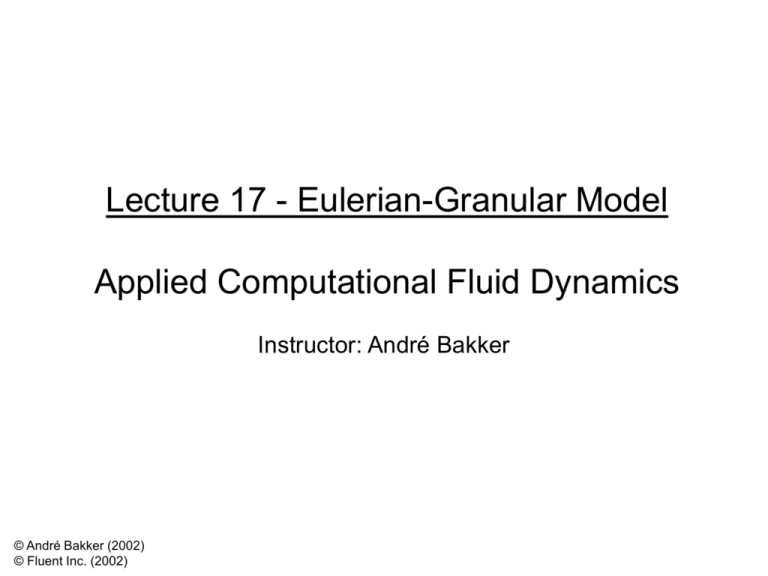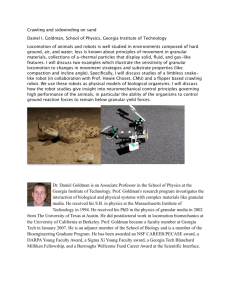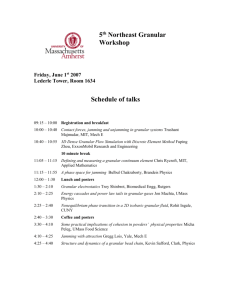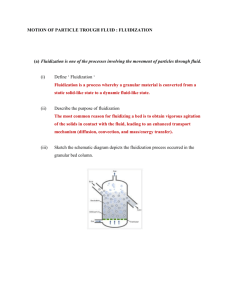Eulerian Granular Multiphase
advertisement

Lecture 17 - Eulerian-Granular Model
Applied Computational Fluid Dynamics
Instructor: André Bakker
© André Bakker (2002)
© Fluent Inc. (2002)
Contents
•
•
•
•
•
•
•
Overview.
Description of granular flow.
Momentum equation and constitutive laws.
Interphase exchange models.
Granular temperature equation.
Solution algorithms for multiphase flows.
Examples.
Overview
• The fluid phase must be assigned as the primary phase.
• Multiple solid phases can be used to represent size distribution.
• Can calculate granular temperature (solids fluctuating energy) for
each solid phase.
• Calculates a solids pressure field for each solid phase.
– All phases share fluid pressure field.
– Solids pressure controls the solids packing limit.
Granular flow regimes
Elastic Regime
Plastic Regime
Viscous Regime.
Stagnant
Slow flow
Rapid flow
Stress is strain
dependent
Strain rate
independent
Strain rate
dependent
Elasticity
Soil mechanics
Kinetic theory
Kinetic theory of granular flow
Kinetic Transport
Collisional Transport
Granular multiphase model: description
• Application of the kinetic theory of granular flow
Jenkins and Savage (1983), Lun et al. (1984), Ding and
Gidaspow (1990).
• Collisional particle interaction follows Chapman-Enskog approach
for dense gases (Chapman and Cowling, 1970).
– Velocity fluctuation of solids is much smaller than their mean
velocity.
– Dissipation of fluctuating energy due to inelastic deformation.
– Dissipation also due to friction of particles with the fluid.
Granular multiphase model: description (2)
• Particle velocity is decomposed into a mean C local velocity and
a superimposed fluctuating random velocity u s.
• A “granular” temperature is associated with the random
fluctuation velocity:
3
1
CC
2
2
Gas molecules and particle differences
• Solid particles are a few orders of magnitude larger.
• Velocity fluctuations of solids are much smaller than their mean
velocity.
• The kinetic part of solids fluctuation is anisotropic.
• Velocity fluctuations of solids dissipates into heat rather fast as a
result of inter particle collision.
• Granular temperature is a byproduct of flow.
Analogy to kinetic theory of gases
Pair distribution
function
Velocity distribution
function
Collisions are brief
and momentarily.
No interstitial fluid
effect.
Free streaming
Collision
Granular multiphase model: description
• Several transport mechanisms for a quantity within the particle
phase:
– Kinetic transport during free flight between collision
Requires velocity distribution function f1.
– Collisional transport during collisions
Requires pair distribution function f2.
• Pair distribution function is approximated
by taking into account
the radial distribution function g o (r , ) into the relation between
and f1 and f2.
Continuity and momentum equations
• Applying Enskog’s kinetic theory for dense gases gives for:
– Continuity equation for the granular phase.
( s s ) ( s s u s ) m fs
t
– Granular phase momentum equation.
Mass transfer
n
( s s us ) ( s s us us ) s p f s ( R fs m fs u fs ) Fs
t
s 1
Fluid pressure
Solid stress tensor
Phase interaction term
Constitutive equations
• Constitutive equations needed to account for interphase and
intraphase interaction:
– Solids stress
Accounts for interaction within
solid phase. Derived from
granular kinetic theory
s
s Ps I 2 s s S s (s 23 s ) u s I
where,
S 12 u s (u s )T
Strain rate
Ps
Solids Pressure
go
Radial distribution function
s , s
Solids bulk and shear viscosity
Constitutive equations: solids pressure
• Pressure exerted on the containing wall due to the presence of
particles.
• Measure of the momentum transfer due to streaming motion of
the particles:
Ps s s s ( 2(1 es ) s gos )
– Gidaspow and Syamlal models:
– Sinclair model:
(1
1
ds
)
6 s D 2
Constitutive equations: radial function
• The radial distribution function g0(s) is a correction factor that
modifies the probability of collision close to packing.
• Expressions for g0(s):
Ding and Gidaspow,
Sinclair.
g o ( s ) 1 s
s ,max
1
3
1
, s ,max 0.65
Syamlal et al.
3 s
1
g o ( s )
1 s 2(1 s ) 2
Constitutive equations: solids viscosity
• The solids viscosity:
– Shear viscosity arises due translational (kinetic) motion and
collisional interaction of particles:
s s ,coll s ,kin
(1 s ) / 2
– Collisional part:
• Gidaspow and Syamlal models:
s ,coll
8
s s d s g os s
5
1
2
• Sinclair model:
s ,col
5d ( )
s s s
96 s
1
2
8 s 8
768 2
1
(
3
2
)
g
s g os
s os
25
52 5
Constitutive equations: solids viscosity
• Kinetic part:
s d s s ( s )
– Syamlal model:
s , kin
12(2 )
– Gidaspow model:
s ,kin
– Sinclair model:
5d ( )
s s s
96g os
1
1
2
8
1
(
3
2
)
g
s
os
5
2
8
1
g
5 os s
5d s s ( s ) 2
8
s ,kin
1 (3 2) s g os
96 s (2 ) g os 5
1
Constitutive equations: bulk viscosity
• Bulk viscosity accounts for resistance of solid body to dilatation:
4
s
s s s d s g os (1 es )
3
• s
• es
• ds
volume fraction of solid.
coefficient of restitution.
particle diameter.
1
2
Plastic regime: frictional viscosity
• In the limit of maximum packing the granular flow regime
becomes incompressible. The solid pressure decouples from the
volume fraction.
• In frictional flow, the particles are in enduring contact and
momentum transfer is through friction. The stresses are
determined from soil mechanics (Schaeffer, 1987).
• The frictional viscosity is:
Ps sin
s , frict
2 I2
• The effective viscosity in the granular phase is determined from
the maximum of the frictional and shear viscosities:
s max s ,coll s ,kin , s , frict
Momentum equation: interphase forces
fs u fs ) 0
( R fs m
n
• Interaction between phases.
s 1
• Formulation is based on forces on a single particle corrected for
effects such as concentration, clustering particle shape and mass
transfer effects. The sum of all forces vanishes.
– Drag: caused by relative motion between phases; Kfs is the drag
between fluid and solid; Kls is the drag between particles
n
( K ls (ul u s )) K fs (u f u s ) 0
l 1
General form for the drag term:
With particle relaxation time:
K fs s s
s ds 2
fs
18 f
f drag
fs
Momentum: interphase exchange models
• Fluid-solid momentum interaction, expressions for fdrag.
–
–
–
–
Arastopour et al (1990).
Di Felice (1994).
Syamlal and O’Brien (1989).
Wen and Yu (1966).
• Drag based on Richardson and Zaki (1954) and/or Ergun (1952).
– use the one that correctly predicts the terminal velocity in dilute flow.
– in bubbling beds ensure that the minimum fluidized velocity is
correct.
– It depends strongly on the particle diameter: correct diameter for
non-spherical particles and/or to include clustering effects.
Comparison of drag laws
• A comparison of the fluid-solid momentum interaction, fdrag, for:
– Relative Reynolds number of 1 and 1000.
– Particle diameter 0.001 mm.
300
14
Syamlal-O'Brien
Schuh
Wen-Yu
Di Felice
Arastopoor
Syamlal-O'Brien
12
250
Schuh
Wen-Yu
10
200
Di Felice
Arastopoor
8
f
f 150
6
4
100
2
50
0
0
0
0.1
0.2
0.3
0.4
0.5
Granular volume fraction
0.6
0
0.2
0.4
Granular Volume Fraction
0.6
Particle-particle drag law
• Solid-solid momentum interaction.
– Drag function derived from kinetic theory (Syamlal et al, 1993).
2
3(1 elm )( Clm ) l l m m (d l d m ) 2 g olm
2
8
K lm
|
u
l um |
2 ( l d l3 m d m3 )
g olm
M
3d m d l
k
2
f f (d l d m ) k 1 d k
1
Momentum: interphase exchange models
• Virtual mass effect: caused by relative acceleration between
phases Drew and Lahey (1990).
u
u
f
s
K vm, fs Cvm s f (
u f u f ) (
us us )
t
t
• Lift force: caused by the shearing effect of the fluid onto the
particle Drew and Lahey (1990).
K k , fs
C L s f (u f u s ) ( u f )
• Other interphase forces are: Basset Force, Magnus Force,
Thermophoretic Force, Density Gradient Force.
Granular multiphase model: mass transfer
• Unidirectional mass transfer: m
fs
• Defines positive mass flow is specified constant rate of rate per
unit volume from phase f to phase s,
fs proportional to: r f s
– m
– particle shrinking or swelling.
• e.g., rate of burning of particle.
– Heat transfer modeling can be included via UDS.
Granular temperature equations
• Granular temperature.
1
C C
3
Production term
3
{ ( s s s ) ( s s us s )} s : us ...
2 t
Diffusion term
Dissipation term due
to inelastic collisions
( s s ) s lm fs
Exchange terms
Constitutive equations: granular temperature
• Granular temperature for the solid phase is proportional to the
kinetic energy of the random motion of the particles.
–
s : u s
represents the generation of
energy by the
solids stress tensor.
–
( s s )
represents the diffusion of energy.
–
s
Granular temperature conductivity.
Constitutive equations: granular temperature
• Granular temperature conductivity.
– Syamlal:
16
15 s s d s s
12
2
(41 33 ) s g os ]
[1 s g os (4 3)
15
4(41 33 )
5
s
– Gidaspow:
s
– Sinclair:
75 s d s s
12
[1 s g os ]2
384g os
5
2 s2 s d s (1 es ) g os
12 2
1
(
4
3
)
g
s os
25 s d s s
5
( ) syamlal
16g os
41 33
s
s
s
Constitutive equations: granular temperature
•
represents the dissipation of energy due to inelastic
s
collisions.
– Gidaspow: s
4
3(1 e ) s g os s
u s
2
s
2
s
– Syamlal and Sinclair:
s
3
12(1 es ) g os
s s s 2
ds
Lun et al (1984)
• Here lm represents the energy exchange among solid phases
(UDS).
Constitutive equations: granular temperature
•
fs represents the energy exchange between the fluid and the
solid phase.
– Laminar flows:
fs 3K fs s
– Dispersed turbulent flows:
• Sinclair:
fs K fs ( 2k f 3 2k f )
• Other models:
fs K fs (2k f u 'pi , u 'fi )
Test case for Eulerian granular model
• Contours of solid
stream function and
solid volume fraction
when solving with
Eulerian-Eulerian
model.
• Contours of solid
stream function and
solid volume fraction
when solving with
Eulerian-Granular
model.
U=7 m/s
Solids=1%
Solution guidelines
• All multiphase calculations:
– Start with a single-phase calculation to establish broad flow patterns.
• Eulerian multiphase calculations:
– Copy primary phase velocities to secondary phases.
– Patch secondary volume fraction(s) as an initial condition.
– For a single outflow, use OUTLET rather than PRESSURE-INLET;
for multiple outflow boundaries, must use PRESSURE-INLET.
– For circulating fluidized beds, avoid symmetry planes (they promote
unphysical cluster formation).
– Set the “false time step for underrelaxation” to 0.001.
– Set normalizing density equal to physical density.
– Compute a transient solution.
Summary
• The Eulerian-granular multiphase model has been described in
the section.
• Separate flow fields for each phase are solved and the interaction
between the phases modeled through drag and other terms.
• The Eulerian-granular multiphase model is applicable to all
particle relaxation time scales and Includes heat and mass
exchange between phases.
• Several kinetic theory formulations available:
• Gidaspow: good for dense fluidized bed applications.
• Syamlal: good for a wide range of applications.
• Sinclair: good for dilute and dense pneumatic transport lines and risers.





